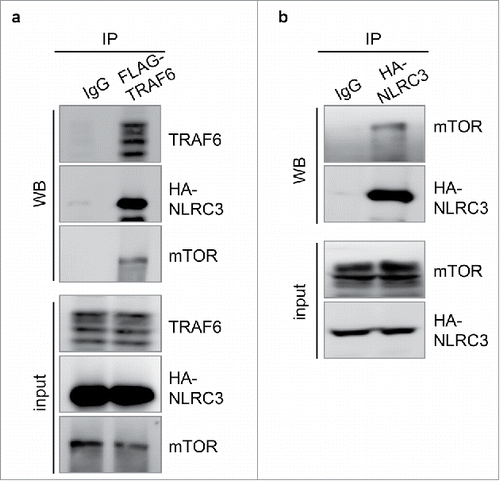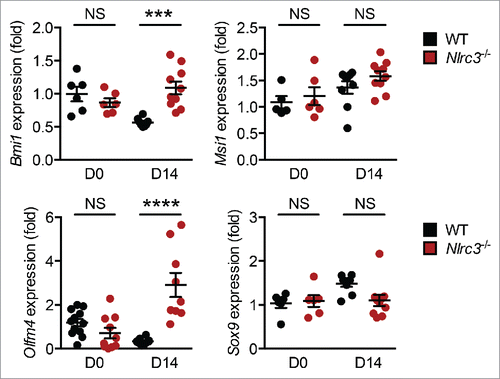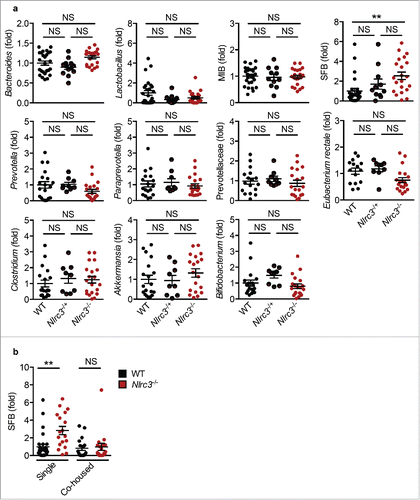Figures & data
Figure 1. NLRC3 sequesters mTOR-TRAF6 complex. (A) Human embryonic kidney (HEK) 293T cells were transfected with the FLAG-TRAF6, HA-NLRC3, and mTOR plasmids. TRAF6 immunoprecipitates were analyzed for TRAF6, HA, and mTOR expression by western blot. (B) 293T cells were transfected with HA-NLRC3 and mTOR plasmids. HA immunoprecipitates were analyzed for mTOR and HA expression. Data represent 1 experiment representative of 2 independent experiments.

Figure 2. NLRC3 regulates cellular proliferation and apoptosis. (A) Immunoblot analysis of caspase-1 (CASP-1), caspase-8 (CASP-8), caspase-3 (CASP-3), and caspase-7 (CASP-7) activation and GAPDH (loading control) in the colon of WT and Nlrc3−/− mice 14 d after AOM injection. (B) Immunoblot analysis of c-Myc, phosphorylated FoxO3a and FoxO1 (P-FoxO3a and P-FoxO1), and GAPDH (loading control) in the colon of WT and Nlrc3−/− mice 14 d after AOM injection. Protein band intensity was normalized to the loading control and expressed relative to that of the WT, set at 1. (C) Images and quantification of the number of cyclin D1+ cells in each crypt of WT (day 0, n = 5; day 14, n = 8) and Nlrc3−/− (day 0, n = 5; day 14, n = 8) mice (left). Scale bar, 200 μm (C). *P < 0.05; **P < 0.01; ***P < 0.001; ****P < 0.0001; NS, not statistically significant [2-tailed t-test (B and C)]. Data are from 1 experiment representative of 2 (mean and s.e.m. in A and C).
![Figure 2. NLRC3 regulates cellular proliferation and apoptosis. (A) Immunoblot analysis of caspase-1 (CASP-1), caspase-8 (CASP-8), caspase-3 (CASP-3), and caspase-7 (CASP-7) activation and GAPDH (loading control) in the colon of WT and Nlrc3−/− mice 14 d after AOM injection. (B) Immunoblot analysis of c-Myc, phosphorylated FoxO3a and FoxO1 (P-FoxO3a and P-FoxO1), and GAPDH (loading control) in the colon of WT and Nlrc3−/− mice 14 d after AOM injection. Protein band intensity was normalized to the loading control and expressed relative to that of the WT, set at 1. (C) Images and quantification of the number of cyclin D1+ cells in each crypt of WT (day 0, n = 5; day 14, n = 8) and Nlrc3−/− (day 0, n = 5; day 14, n = 8) mice (left). Scale bar, 200 μm (C). *P < 0.05; **P < 0.01; ***P < 0.001; ****P < 0.0001; NS, not statistically significant [2-tailed t-test (B and C)]. Data are from 1 experiment representative of 2 (mean and s.e.m. in A and C).](/cms/asset/c1ea7116-1571-4d58-a4f4-ba14588e9178/kccy_a_1317414_f0002_c.gif)
Figure 3. NLRC3 regulates stem cell markers. Relative expression of genes encoding BMI1, MSI1, OLFM4, and SOX9 in colon tissues of untreated WT and Nlrc3−/− mice or in WT and Nlrc3−/− mice 14 d after AOM injection. Each symbol represents 1 mouse. ***P < 0.001; ****P < 0.0001; NS, not statistically significant (2-tailed t-test). Data represent 2 independent experiments (mean and s.e.m.).

Figure 4. Landscape of gut microbiota in Nlrc3−/− mice. (A) Levels of Bacteroides, Lactobacillus, mouse intestinal Bacteroides (MIB), segmented filamentous bacteria (SFB), Prevotella, Paraprevotella, Prevotellaceae, Eubacterium rectale, Clostridium, Akkermansia, and Bifidobacterium in untreated WT, Nlrc3−/+ and Nlrc3−/− mice. (B) Levels of SFB in separately housed (single housed) WT and Nlrc3−/− mice and co-housed WT and Nlrc3−/− mice. The level of genes was expressed relative to that of the WT, set at 1. Each symbol represents 1 mouse. **P < 0.01; NS, not statistically significant (2-tailed t-test). Data represent 2 independent experiments (mean and s.e.m.).


